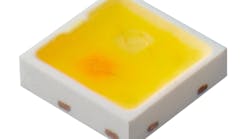Cree continued on its string of strong financial quarters, especially relative to 2012. Epistar will leverage Intermolecular R&D methodology to speed LED developments. Philips Lumileds has added another LED distributor in Mouser. And Toshiba has acquired the silicon-based LED manufacturing assets of Bridgelux while a question remains as to whether such technology can actually lower LED cost and spur solid-state lighting (SSL) deployment.
Cree earnings
Cree reported Q3 2013 earnings during the busy Lightfair week, and again showed evidence of growth. Quarter-over-quarter revenue growth dropped to 1% at $348.9 million, although that represents a 23% increase over the same quarter from the prior year. GAAP net income for the quarter at $22.2 million was up more steeply from $9.5 million in the same quarter the prior year.
"Fiscal Q3 was another good quarter with record revenue and earnings per share that were on the high end of our target range," stated Chuck Swoboda, Cree chairman and CEO. "Overall company backlog is ahead of this point last quarter and we are targeting solid growth for Q4. We remain focused on using new product innovation to grow our business and build the Cree brand."
The company noted a number of technology highlights and those achievements are part of the reason for the company's continued optimism. Specifically Cree pointed out the success of its sub-$15 LED retrofit lamps. And on the component side the 276-lm/W laboratory efficacy milestone was highlighted.
Epistar and Intermolecular partner
Intermolecular announced a partnership with Epistar designed to accelerate efficacy improvements and reduce the cost of the LED manufacturer's components. Intermolecular developed an R&D platform called the High Productivity Combinatorial (HPC) platform that can support quick iteration of R&D experiments for applications in the semiconductor and clean energy spaces, and now for the first time specifically applied to LEDs.
Presumably, the combinatorial-chemical HPC platform will support both faster development of improved LED structures and faster transfer of developments into production. "After a rigorous review of Intermolecular's capabilities through an initial collaboration engagement, we have seen how their combinatorial approach to materials innovation and device integration can augment Epistar's leadership in LED technology," said M. J. Jou, president of Epistar. "We are confident that leveraging Intermolecular's team and technology platform will further increase our competitive advantage."
Intermolecular says that HPC can allow R&D experiments in semiconductors to proceed 100 times faster than conventional methods. "Entering into a strategic engagement with a top-tier LED company like Epistar validates the applicability and disruptive potential of the HPC technology platform for LEDs, a market that continues to have tremendous room for growth and technology innovation," said Sandeep Nijhawan, senior vice president and general manager of Intermolecular's clean energy group.
Mouser to distribute Philips Lumileds
After the breakup with former exclusive distributor Future Lighting Solutions, Philips Lumileds continues to broaden its distribution partnerships now adding Mouser on a global basis. "Mouser gives Philips Lumileds the opportunity to bring our comprehensive portfolio of application specific LEDs to an even broader group of new and innovative companies," said Emmanuel Dieppedalle, senior vice president of sales and marketing at Lumileds. "This partnership is the perfect avenue for our extensive product line to quickly meet the demands of our rapidly growing customer base."
"We are excited to partner with Philips Lumileds to deliver the newest in lighting solution designs," said Russell Rasor, Mouser vice president of advanced technology. "Philips Lumileds is on the leading edge of technology and provides high quality lighting equipment. Their vision is to bring the small form factor, long life span, and other benefits of solid-state illumination based on LEDs to general lighting applications such as light fixtures, traffic signals, automotive, signaling, and LCD displays through power LED technology."
Bridgelux sells silicon IP to Toshiba
On the first day of Lightfair, Bridgelux and Toshiba announced major changes in their partnership focused on a transition to silicon substrates for manufacturing LEDs. The press release issued by the two implied an extended collaboration. But Bridgelux has apparently given up its plan to produce gallium-nitride-on-silicon (GaN-on-SI) LEDs itself.
"Our agreement with Toshiba marks a tremendous milestone in our long history of working closely together, allowing Bridgelux to capitalize on our strong core LED technology platform, providing us with significant new capital for growth, and reducing our capital requirements," said Brad Bullington, CEO of Bridgelux. “This agreement also allows us to focus on what we do best, and what we think the market needs most at this point in time: commercializing, productizing and bringing to market LED-based solid state lighting technologies alongside a proven global scale semiconductor manufacturing partner."
As you may note reading between the lines in the quote, Toshiba will pay Bridgelux additional, but undisclosed, licensing/acquisition fees that will alleviate what have been ongoing cash concerns at Bridgelux despite additional venture funding and an infusion of cash from Toshiba last year.
The new agreement also apparently marks the end of Bridgelux's long-stated plans to build a major LED fab in the US. The move away from a fab will further lessen the financial burden on Bridgelux, although its prime focus apparently remains on the packaged LED space.
Toshiba, meanwhile, has said that it is shipping GaN-on-SI LEDs. Competitors continue to question that stance, and indeed no products that use the LEDs have been verified on the market, Also, no other competitor in the GaN-on-Si has shipped production volumes yet either.




